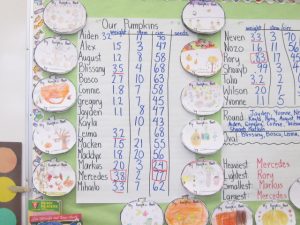After our trip to the Laity Pumpkin Patch, we did some Mathematical explorations with our picked pumpkins. These involved the concept of estimations. I gave the students a baseline to judge by with my pumpkin – i.e. its weight, stem length, circumference. Students then did their own ‘good guesses’ on their pumpkins (in comparison to mine) in regard to:
- the number of vertical lines
- the length (in centimetres) of the stem
- the weight (in kilograms)
- the circumference (in centimetres)
- how many seeds are inside
Then students did the actual counting of lines, the weighing, and the measuring of the stem and circumference. We charted the numbers for each student and determined who had:
- the heaviest one
- the lightest one
- the smallest one (circumference)
- the largest one (circumference)
- round shaped pumpkins
- oval shaped pumpkins
Students then completed their booklets. These are pinned to a bulletin board in our room. They look like this …
The pumpkins were sent home on Tuesday. Once the students have carved their pumpkins at home, they are asked to count the number of seeds inside their pumpkin. They should then write the number in their planner so that they can record it in their booklet. They are also asked to bring in 6 seeds to glue into their booklets. This is from a story we read called, ‘Pumpkin, Pumpkin’ about a boy named Jamie who grew a pumpkin and at the end, after carving his Jack O’Lantern, he saved six seeds to plant the following Spring.
Thank you for helping your child do these two final stages to complete their booklets.

